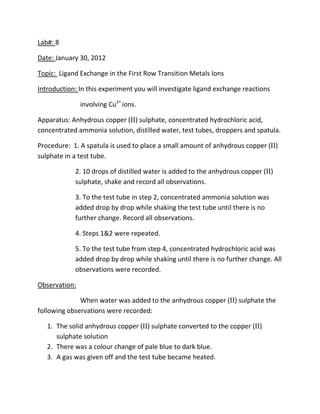Report
Share

Recommended
Recommended
More Related Content
What's hot
What's hot (20)
CSEC Physics Lab - IV Relationship of a filament lamp

CSEC Physics Lab - IV Relationship of a filament lamp
CAPE Chemstry 2012 U1 P2 Q1 Past Paper Answer And Explanations

CAPE Chemstry 2012 U1 P2 Q1 Past Paper Answer And Explanations
CSEC Physics PD Lab - Factors affecting strength of electromagnet

CSEC Physics PD Lab - Factors affecting strength of electromagnet
CAPE Communication Studies - The language analysis

CAPE Communication Studies - The language analysis
CSEC Physics Lab - Half Life of liquid draining from burette

CSEC Physics Lab - Half Life of liquid draining from burette
CXC CAPE Communication Studies-Language techniques

CXC CAPE Communication Studies-Language techniques
CSEC Physics Lab - Effect of string length on the period of a pendulum

CSEC Physics Lab - Effect of string length on the period of a pendulum
Viewers also liked
Further explanation on the chemical properties of the first row transition elements. Good LuckInorganic Chemistry : Transition Elements (Chemical properties of first row i...

Inorganic Chemistry : Transition Elements (Chemical properties of first row i...Thivyaapriya Sambamoorthy
Viewers also liked (16)
chemical lab report:Synthesis and properties of a cobalt cage complex

chemical lab report:Synthesis and properties of a cobalt cage complex
Inorganic Chemistry : Transition Elements (Chemical properties of first row i...

Inorganic Chemistry : Transition Elements (Chemical properties of first row i...
Synthesis and identification of nickel (ll) , cobalt (ll) and copper (ll) com...

Synthesis and identification of nickel (ll) , cobalt (ll) and copper (ll) com...
Chemical lab report:Analysis of anions(in toothpaste Berocca and an unknown s...

Chemical lab report:Analysis of anions(in toothpaste Berocca and an unknown s...
Similar to Chemisrty lab # 8
Similar to Chemisrty lab # 8 (20)
Class 12 Chemistry Practical By Bharat Panchal.pdf

Class 12 Chemistry Practical By Bharat Panchal.pdf
Investigating The Kinetics Of The Reaction Between Iodide...

Investigating The Kinetics Of The Reaction Between Iodide...
Chemistry prediction of products and workshop homework

Chemistry prediction of products and workshop homework
More from Robert Edwards
More from Robert Edwards (20)
Chemisrty lab # 8
- 1. Lab#: 8 Date: January 30, 2012 Topic: Ligand Exchange in the First Row Transition Metals Ions Introduction: In this experiment you will investigate ligand exchange reactions involving Cu2+ ions. Apparatus: Anhydrous copper (II) sulphate, concentrated hydrochloric acid, concentrated ammonia solution, distilled water, test tubes, droppers and spatula. Procedure: 1. A spatula is used to place a small amount of anhydrous copper (II) sulphate in a test tube. 2. 10 drops of distilled water is added to the anhydrous copper (II) sulphate, shake and record all observations. 3. To the test tube in step 2, concentrated ammonia solution was added drop by drop while shaking the test tube until there is no further change. Record all observations. 4. Steps 1&2 were repeated. 5. To the test tube from step 4, concentrated hydrochloric acid was added drop by drop while shaking until there is no further change. All observations were recorded. Observation: When water was added to the anhydrous copper (II) sulphate the following observations were recorded: 1. The solid anhydrous copper (II) sulphate converted to the copper (II) sulphate solution 2. There was a colour change of pale blue to dark blue. 3. A gas was given off and the test tube became heated.
- 2. When Hydrochloric acid was added to the copper (II) sulphate solution there was a colour change from dark blue to green and a pungent gas was given off. Discussion: 1. A ligand is a species that can donate one lone pair of electrons; this allows a ligand to form complexes with transition metals. 2. A ligand is a species that can donate one lone pair of electrons; this allows a ligand to form complexes with transition metals. The ligand would donate the appropriate amount of lone pair electrons to the transition metal thus forming the complex. 3. Ligand exchange states that when a ligand is added to a complex, if the ligand is stronger than the ligand is stronger than the one in the complex it will be displaced, as what occurred in the experiment. 4. During the experiment the following complexes were formed Tetra aqua copper (II) ions, Tetra chloro copper (II) ions and Tetra ammin copper (II) ions. 5. The chloride and ammonium ion were able to displace the H2O in the complexes formed due to the laws of ligand exchange, which states that if the ligand added to the complex is stronger than the one in the complex it will displace the weak ligand. 6.